How to Tell Greek Revival from Colonial Revival and More
Excerpts from the Architectural Style Guide reprinted with permission from Historic New England, historicnewengland.org
This Architectural Style Guide is intended as a general introduction to American domestic architecture, and common stylistic trends of New England architecture, beginning with seventeenth-century colonial architecture through the Colonial Revival architecture of the early twentieth century.
Post-Medieval English: 1600-1700
Built during the first generation of settlement by English colonists, Post-Medieval English (or First Period) architecture owes much of its appearance to building traditions from Europe. In New England, colonists departed from traditional European wattle and daub (woven lattice of wooden strips covered with a material made with some combination of wet soil, clay, sand, animal dung, and straw), constructing wood-frame homes covered with weatherboard, clapboard, or shingles. This was a direct result of the prevalence of local timber. In addition, New England seventeenth-century homes were typically two stories tall with steeply pitched roofs, essential for shedding heavy snow loads. Central chimneys were also standard, being the most efficient way to heat these buildings during cold New England winters. Today, surviving examples have almost all been restored to their early appearance and thus retain very little original material.
Post-Medieval English architecture is limited to those areas of the country settled before 1700. Connecticut and coastal regions of Massachusetts contain the highest number of these structures, although other examples can be found moving inland along major waterways such as the Hudson River.
The dominant style for domestic construction in the United States from 1700 to 1780, Georgian architecture grew out of the Italian Renaissance in Europe. Andrea Palladio (1508-1580), an Italian architect, devised a set of design principles based on the Classical proportions of Roman ruins. In turn, these principles were brought to the colonies, gaining popularity beginning around 1700 principally through architectural pattern books.
Georgian architecture gets its name from the succession of English kings named George (beginning in 1715). In the United States the style included innumerable variations on a simple English theme: a symmetrical, two-story house with center-entry façade, combined with the two-room-deep center-passage floor plan. By the end of the seventeenth century, the upper classes in the colonies began to embrace the European concept of gentility, displaying their elevated taste and station by maintaining codes of dress, speech, and behavior. This status was also aptly displayed by the orderly symmetry of Georgian architecture, a legacy that survives today.
Federal: 1780-1820
Like the preceding Georgian period, domestic architecture in the Federal style typically came in the form of a simple box, two rooms deep, with doors and windows arranged in strict symmetry; however, creative floor plans with elliptical and round spaces were introduced during this period and the simple exterior box was often modified by projecting wings (particularly in high-style examples). In addition, there is a lightness and restrained delicacy to Federal architectural components in comparison to their heavier, more ponderous Georgian counterparts.
The Federal style is often described as a refinement of Georgian style drawing on contemporary European trends. During this period, the first true architects appeared on the American scene. Among them was Charles Bulfinch (1763-1844) who is credited with bringing the Federal style to United States after his own European tour. Asher Benjamin’s (1773-1845) famous pattern books brought Bulfinch’s interpretations of the Adam style to thousands of American carpenters and house wrights.
Federal architecture was a sign of urban prosperity, reflecting the growing wealth of the new nation.
Greek Revival: 1825-1860
Increasing interest in classical buildings in both western Europe and the United States at the end of the eighteenth century first focused on Roman models. The Roman legacy can be seen in Early Classical Revival homes in the southern regions of the east coast, particularly Virginia. Increasingly, however, archaeological investigations of the early nineteenth century focused on Greece (as the mother of Rome) and shifted interest to Grecian architectural models. At the same time, the War of 1812 increased American resentments of British influence. These factors led to a flowering of what is now known as Greek Revival architecture.
“Grecian Style” swept through the country with western expansion. Taking many shapes, it was the classic form of the Parthenon which inspired design of Bank of the United States in Philadelphia (1818), and served as a catalyst, identifying Grecian architecture with economic security. The National style, as it came to be known, became the universal fashion for public buildings, churches, banks, and town halls.
Greek Revival was the dominant style of domestic architecture between 1830 and 1850.
As in previous centuries, Americans of the early nineteenth century were influenced by the cultural movements of Europe, including the Picturesque. In 1832 the first example of Gothic Revival architecture in the United States was designed by architect Alexander Jackson Davis (1803-1892). Americans put their own twist on the Gothic style, using details such as pointed arches on light wood-framed construction in a variation that is known as Carpenter Gothic.
By 1865 the Gothic Revival style was declining in popularity. It enjoyed a brief resurgence in the 1870s, stimulated by the writings of English art historian critic John Ruskin. This High Victorian Gothic phase was principally applied to public buildings such as churches and libraries with a few landmark houses with the definitive polychrome cladding (distinctive linear patterns in masonry distinguished by horizontal bands of contrasting colors or textures of brick or stonework).
Never as popular as the contemporary Greek Revival or Italianate styles for domestic architecture, most surviving examples exist in northeastern states where architects first popularized the style.
Italianate: 1840-1885
As with Gothic Revival, the Italianate style began in Europe as part of the Picturesque movement, a reaction against the formal classical ideals in art and architecture that had dominated the previous two centuries. It was inspired by the rambling, informal Italian villas of northern Italy with their characteristic square towers and asymmetrical, open floor plans.
The first Italianate houses in the United States were constructed in the late 1830s, popularized by the pattern books of Andrew Jackson Downing similar to the Gothic Revival. By the 1860s however, the Italianate style surpassed the slightly earlier Gothic Revival in popularity. In the United States two separate approaches can be seen in domestic examples. One was more directly inspired by the traditional Italian villa with its masonry construction, square towers, and irregular massing and floor plans.
This is distinguished from a more formal, symmetrical, and familiar townhouse or detached Greek Revival box to which Italianate ornamentation such as eave brackets and arched windows were applied. The combination of a familiar form and the “picturesque” decoration helped the style maintain its dominance through the third quarter of the nineteenth century. In fact, vernacular examples developed into a truly American style with only passing reference to Italian models. The financial panic of 1873 and the subsequent economic depression directly led to the decline of the Italianate style.
Second Empire: 1855-1885
Following the Civil War, a population explosion in the cities and towns of the northern and western United States naturally led to a huge demand for new housing. At the same time, house design books and building parts catalogues were becoming available nationally and streetcars and trains brought newer, more distant suburbs with space for large new houses within commuting distance of major cities. These factors along with a postwar industrial and economic energy resulted in the flowering of a variety of new architectural styles. Overall floor plans and forms became more varied and complex, with styles increasingly defined by the shapes of door and window openings and applied decoration at windows, doors, porches, and particularly front entries.
The Second Empire (or French Second Empire) style was considered to be the modern fashion of the late nineteenth century, mimicking the latest French building styles. Its distinctive mansard roof was named for an early French architect, Francois Mansart (1598-1666), and was used extensively during the reign of Napoleon III (1852 – 1870), France’s Second Empire. Exhibitions in Paris in 1855 and 1867 helped to popularize the style internationally. The mansard roof became particularly popular in urban areas where it provided a full attic story of living space and was also commonly used in remodeling older buildings. Houses in the Second Empire style are essentially defined by this distinctive roof type, with other detailing reflecting a number of different fashions (most commonly Italianate details) or even a combination of several different styles.
The Second Empire style rapidly faded from popularity following the panic of 1873 and subsequent economic depression.
The Stick Style is often considered to be a transitional style, linking the preceding Gothic Revival with the subsequent Queen Anne. All three were inspired by the building traditions of Medieval English half-timbered construction with its visible structural elements, steeply pitched roofs, and projecting gables. Unlike Gothic Revival, the Stick Style stressed the wall surface itself rather than applying decorative elements merely at windows, doors, and cornices. Various patterns of wood clapboards or board-and-batten siding were applied within square and triangular spaces created by the raised stick work. This detailing was applied to a variety of nineteenth-century building forms, making it the defining element of the style.
The Stick Style is a celebration of wood construction and in many ways the “structure” as defined by the stick work is the decoration. The undecorated, square-milled lumber gives a precise, geometric quality to Stick Style homes. Advocates additionally promoted the Stick Style’s structural “honesty” because the stick work was meant to express the building’s internal structure; however, unlike true half-timbering, stick work was merely applied decoration with no true relation to the underlying balloon-frame construction. During the 1880s the Stick Style was rapidly replaced by the related Queen Anne movement, which was both more widespread and influential.
Examples survive primarily in the northeastern United States and date from the 1860s and ’70s. It is likely that many original examples are now obscured, as their characteristic wall patterns and detailing, susceptible to deterioration, have been removed rather than repaired or replaced.
Queen Anne: 1880-1910
The standard for domestic architecture during the Victorian era in the United States, the Queen Anne style is difficult to define, encompassing a wide range of architectural elements and borrowing and combining features from multiple stylistic traditions. The initial inspiration came from England, but developed into something uniquely American.
American architect Henry Hobson Richardson (1838-1886) designed the first Queen Anne home in the United States in 1874, Watts-Sherman House in Newport, Rhode Island. The style also gained popularity as a result of exposure at the Philadelphia Exposition of 1876, promotion in the country’s first architectural magazine, The American Architect and Building News, and in new plan books available by mail order nationwide. Advancing technology also played a role in spreading the Queen Anne style across the country, with pre-cut architectural details readily available and affordable thanks to mass-production and railway distribution.
The defining feature of the American Queen Anne style is the use of varied wall planes and forms using bays, towers, overhangs, wall projections, and multiple wall materials and textures to avoid any flat or plain expanses.
Queen Anne homes are nearly ubiquitous throughout the country, particularly west of the Appalachians and prominently in California from San Diego to San Francisco, with both townhouses and free-standing examples.
Shingle Style: 1880-1900
Unlike preceding architectural styles, the Shingle Style is not defined by applied decoration and therefore there is little in the way of applied detailing at the doors, windows, cornices, porches, or on wall surfaces of Shingle Style homes. Instead, the focus of the Shingle Style aesthetic was complex shapes and forms encased within a smooth surface of wooden shingles meant to unify the irregular outline of the house. Also unlike preceding styles, the Shingle Style was uniquely American. Even so, it borrowed certain design elements from a variety of contemporary styles, such as the wide porches, shingled surfaces, and asymmetrical forms from Queen Anne designs. It also adapted gambrel roofs, lean-to additions, classical columns, and Palladian windows from the Colonial Revival movement and Syrian arches and the use of stone at the ground story from the concurrent Richardsonian Romanesque style.
The Shingle Style was never adopted or adapted for mass or vernacular housing, remaining a largely high-style, architect-designed aesthetic. As a largely architect-designed style, it was a consciously created American form and a reaction to the mail-order architecture that was popular during the 1880s.
The Shingle Style reached its highest expression in seaside resorts of the northeastern United States – summer destinations such as Newport, Rhode Island; Cape Cod, Massachusetts; eastern Long Island; and coastal Maine. Scattered examples were constructed in all regions of the country though few vernacular examples exist. Despite being well-publicized in contemporary architecture magazines, the Shingle Style never gained the popularity of Queen Anne designs and thus surviving examples are unusual outside of coastal New England. It was also unsuitable to dense urban areas because of its typically expansive floor plan and wood construction.
The Philadelphia Centennial of 1876 is usually credited as the starting point for a rebirth of interest in the colonial architectural heritage of this country. It is not surprising that in celebrating one hundred years as an independent nation Americans proudly looked to the past for inspiration. The simplicity of colonial designs and honest use of materials with more economical plans than the recently popular Picturesque homes also contributed to the growing popularity of the style.
Early Colonial Revival examples were rarely historically accurate, with exaggerated forms and elements that took inspiration from the details of colonial precedents. Georgian and Federal examples had the largest influence on the revival with elements such as colonial door surrounds, multi-pane sash windows, and cornice dentils on a symmetrical façade. Secondary influences came from Post-Medieval English and Dutch Colonial examples, evident in gambrel-roofed examples or later Colonial Revival examples with second-story overhangs. More researched and accurate examples appeared between 1915 and 1935, aided by the publication of a large number of books and periodicals on the subject of colonial architecture; however, the economic depression of the 1930s followed by World War II led to a simplification of the style in later examples with stylized door surrounds, cornices, or windows merely suggesting a colonial precedent.
Historic New England is the oldest and largest regional heritage organization in the nation, with a mission to save and share New England’s past to engage and inform present and future generations. Its more than three dozen museum properties span five states and four centuries of New England life. For more information, visit historicnewengland.org.

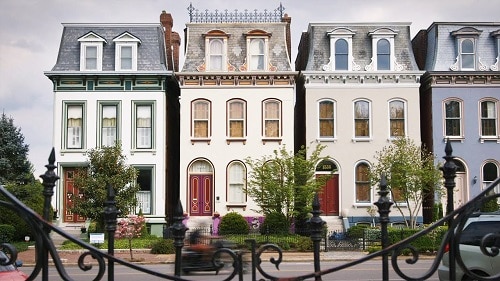
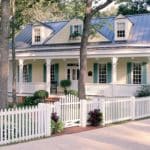

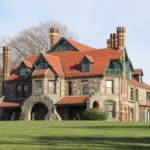
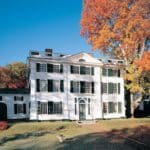




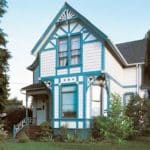





Related posts: